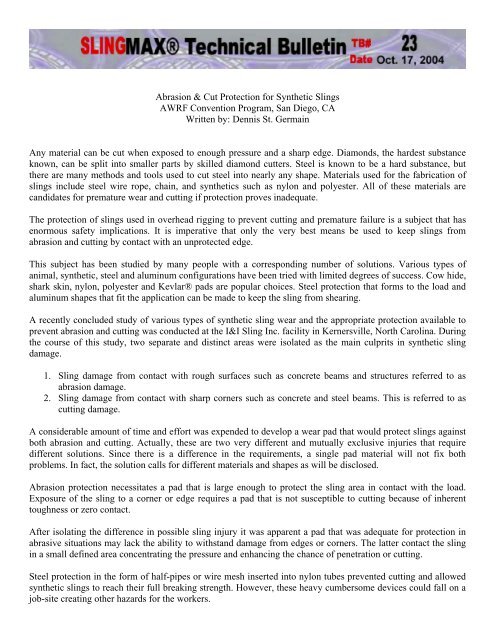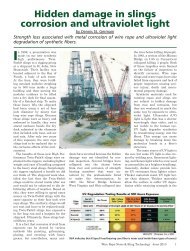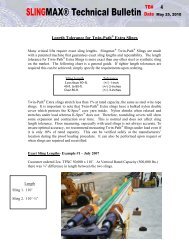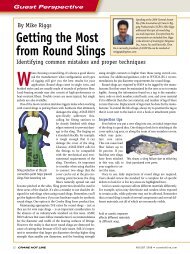Abrasion & Cut Protection for Synthetic Slings AWRF ... - Slingmax Inc
Abrasion & Cut Protection for Synthetic Slings AWRF ... - Slingmax Inc
Abrasion & Cut Protection for Synthetic Slings AWRF ... - Slingmax Inc
You also want an ePaper? Increase the reach of your titles
YUMPU automatically turns print PDFs into web optimized ePapers that Google loves.
<strong>Abrasion</strong> & <strong>Cut</strong> <strong>Protection</strong> <strong>for</strong> <strong>Synthetic</strong> <strong>Slings</strong><br />
<strong>AWRF</strong> Convention Program, San Diego, CA<br />
Written by: Dennis St. Germain<br />
Any material can be cut when exposed to enough pressure and a sharp edge. Diamonds, the hardest substance<br />
known, can be split into smaller parts by skilled diamond cutters. Steel is known to be a hard substance, but<br />
there are many methods and tools used to cut steel into nearly any shape. Materials used <strong>for</strong> the fabrication of<br />
slings include steel wire rope, chain, and synthetics such as nylon and polyester. All of these materials are<br />
candidates <strong>for</strong> premature wear and cutting if protection proves inadequate.<br />
The protection of slings used in overhead rigging to prevent cutting and premature failure is a subject that has<br />
enormous safety implications. It is imperative that only the very best means be used to keep slings from<br />
abrasion and cutting by contact with an unprotected edge.<br />
This subject has been studied by many people with a corresponding number of solutions. Various types of<br />
animal, synthetic, steel and aluminum configurations have been tried with limited degrees of success. Cow hide,<br />
shark skin, nylon, polyester and Kevlar® pads are popular choices. Steel protection that <strong>for</strong>ms to the load and<br />
aluminum shapes that fit the application can be made to keep the sling from shearing.<br />
A recently concluded study of various types of synthetic sling wear and the appropriate protection available to<br />
prevent abrasion and cutting was conducted at the I&I Sling <strong>Inc</strong>. facility in Kernersville, North Carolina. During<br />
the course of this study, two separate and distinct areas were isolated as the main culprits in synthetic sling<br />
damage.<br />
1. Sling damage from contact with rough surfaces such as concrete beams and structures referred to as<br />
abrasion damage.<br />
2. Sling damage from contact with sharp corners such as concrete and steel beams. This is referred to as<br />
cutting damage.<br />
A considerable amount of time and ef<strong>for</strong>t was expended to develop a wear pad that would protect slings against<br />
both abrasion and cutting. Actually, these are two very different and mutually exclusive injuries that require<br />
different solutions. Since there is a difference in the requirements, a single pad material will not fix both<br />
problems. In fact, the solution calls <strong>for</strong> different materials and shapes as will be disclosed.<br />
<strong>Abrasion</strong> protection necessitates a pad that is large enough to protect the sling area in contact with the load.<br />
Exposure of the sling to a corner or edge requires a pad that is not susceptible to cutting because of inherent<br />
toughness or zero contact.<br />
After isolating the difference in possible sling injury it was apparent a pad that was adequate <strong>for</strong> protection in<br />
abrasive situations may lack the ability to withstand damage from edges or corners. The latter contact the sling<br />
in a small defined area concentrating the pressure and enhancing the chance of penetration or cutting.<br />
Steel protection in the <strong>for</strong>m of half-pipes or wire mesh inserted into nylon tubes prevented cutting and allowed<br />
synthetic slings to reach their full breaking strength. However, these heavy cumbersome devices could fall on a<br />
job-site creating other hazards <strong>for</strong> the workers.
Another method that precluded penetration of the sling by exposure to edges was the change in geometric shape<br />
of the edge itself. This was accomplished by riggers when they would place a wooden 2” x 4” on either side of<br />
the edge thus causing the sling to pass by the edge without making contact.<br />
Newer devices such as the CornerMax® pad change the geometric shape of the load edge and actually prevent<br />
sling contact up to 25,000 lbs per inch of width.<br />
Testing of all types of material on a steel edge showed that the best could withstand cutting only to 11,400 lbs.<br />
This is short of the required 25,000 lbs per inch of width and falls short of minimum requirements of 12,500 lbs<br />
per inch of width.<br />
It is up to individual sling suppliers to verify protection <strong>for</strong> abrasion and edge protection. This is one area<br />
where field trials are not a good idea. In fact, if you do not have tests to show that your methods of cut<br />
protection actually meet the requirements of your synthetic slings you could be in real trouble in a product<br />
liability lawsuit.<br />
An EN2-901 nylon web endless sling has a rated capacity of 12,200 lbs in a vertical basket hitch. If the<br />
customer asks <strong>for</strong> edge protection and you supply anything other than CornerMax® pads or a steel protector,<br />
you will lose a law suit if the sling fails from cutting. Every material we have tested exposed to an edge will fail<br />
below 12,200 lbs per inch of width except the CornerMax® pad or some <strong>for</strong>m of steel protection.<br />
Dennis St. Germain
SLING PROTECTION<br />
Most synthetic sling accidents are caused by cutting. There are many kinds of protective<br />
sleeves and pads available, but only two synthetic protectors provide adequate cut protection:<br />
CornerMax® pads and CornerMax® sleeves. They have been engineered and tested to provide<br />
25,000 lbs. of protection per inch of sling width (4464 kg per centimeter of sling width).<br />
CornerMax® pads are designed <strong>for</strong> 90° straight edges. CornerMax® sleeves are <strong>for</strong> other edges –<br />
curved, rough, or irregular – and are the protection of choice <strong>for</strong> I-beams. For synthetic slings,<br />
the most critical decision is whether cut protection is needed.<br />
<strong>Cut</strong> <strong>Protection</strong> – Engineered Softeners<br />
CornerMax® pads are shown in the right two photos.<br />
The pad creates a “tunnel” of cut protection – a<br />
no-touch zone. There<strong>for</strong>e, the edge does not come<br />
in contact with the pad or<br />
sling. Note that the sides<br />
of the pads must be completely<br />
supported in order<br />
to create and maintain<br />
the “tunnel”.<br />
CornerMax® sleeves may look like traditional protection sleeves, but ours are<br />
made of Dyneema® fiber that is specially woven to provide cut protection <strong>for</strong><br />
a variety of edges and surfaces. Most commonly<br />
used sleeve material cannot stop an edge from<br />
cutting the sleeve and possibly the sling too.<br />
For test results, see the chart on the reverse side.<br />
Call your <strong>Slingmax</strong> Rigging Solutions<br />
dealer <strong>for</strong> assistance in making the right<br />
choice <strong>for</strong> protecting your rigging.<br />
®
This chart shows the results of testing<br />
slings protected by 12 different synthetic<br />
materials that are often used <strong>for</strong> sling<br />
protection. In our tests, ten of the most<br />
commonly used materials do not allow<br />
a sling to reach its working load be<strong>for</strong>e<br />
the sling is cut and fails. The CornerMax®<br />
pad and sleeve allow the synthetic<br />
sling to meet its working load with no<br />
damage to the sling or the protection.<br />
Other Sling<br />
<strong>Protection</strong>...<br />
Damaged or misused protection can result in sling damage or failure. Inspect<br />
be<strong>for</strong>e each use <strong>for</strong> cuts, tears, or damage that may prevent protection of<br />
the sling. Ensure that protection is the correct size and type to protect the<br />
sling. Prevent the sling and its protection from sliding across the load edge.<br />
DEATH or INJURY can occur from improper use, maintenance, or inspection.<br />
MAXIMUM LOADING: 25,000 lb. per inch of sling width (4464 kg/cm of sling width).<br />
100%<br />
% OF BREAK STRENGTH<br />
20%<br />
CornerMax® Pad<br />
CornerMax® Sleeve<br />
Nylon Webbing<br />
Your <strong>Slingmax</strong> Rigging<br />
Solutions dealer can<br />
help you make the right<br />
choice <strong>for</strong> protecting<br />
your rigging. Call today!<br />
Successfully tested to<br />
25,000 lbs. per inch of sling width<br />
4464 kg. per centimeter of sling width<br />
WORKING LOAD<br />
Seat Belt Webbing<br />
1/4” Rubber Pad<br />
Leather Pad<br />
Spectra® Shield<br />
Per<strong>for</strong>mance Pad<br />
(3/8” thick)<br />
Sometimes cut protection is not needed. We have a<br />
full line of engineered softeners that are excellent<br />
<strong>for</strong> abrasion protection or <strong>for</strong> protecting a load<br />
surface. The Shackle Pin pad is<br />
designed to prevent a synthetic<br />
sling from damage when a<br />
sling is seated on the pin side<br />
of a shackle.<br />
SLINGMAX ® and CornerMax ® trademarks are the property of<br />
<strong>Slingmax</strong>, <strong>Inc</strong>. Dyneema ® trademark is the property of DSM N.V.<br />
P.O. BOX 2423 • ASTON, PA 19014-2423 USA<br />
TEL: 800-874-3539 • 610-485-8500 FAX: 610-494-5835<br />
www.slingmax.com<br />
Kevlar® Felt<br />
Double Wall<br />
Cover<br />
Per<strong>for</strong>mance<br />
Pad (1/4” thick)<br />
Baseline<br />
(no protection)<br />
®
Testing of 10-inch Cornermax ® /Dyneema ® Sleeve<br />
02/01/2010<br />
The 8” wide sling was then pulled to its<br />
basket capacity of 300,000 lbs., which<br />
exerted 37,500 lbs. of pressure per inch<br />
of sling width.<br />
The 10” Cornermax ® /Dyneema ®<br />
Sleeve was placed over a TPXC<br />
15,000 and pulled over the 90°<br />
edges of a sharpened steel plate.<br />
No damage was found on the Cornermax ® /<br />
Dyneema ® Sleeve after this test.<br />
NOTE: The 10-inch Cornermax ® /Dyneema ®<br />
Sleeve is rated and tested <strong>for</strong> a maximum of<br />
25,000 lbs. per inch of sling width.<br />
MAXIUM LOADING: Do NOT exceed 25,000 lbs. per inch of sling.





